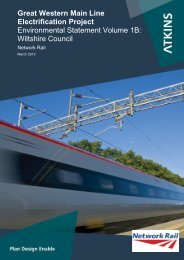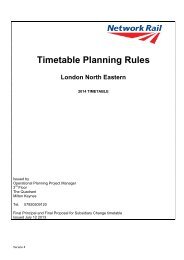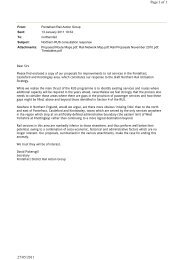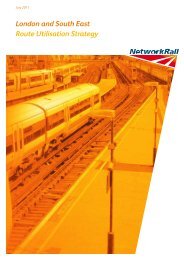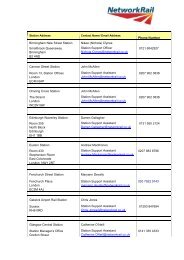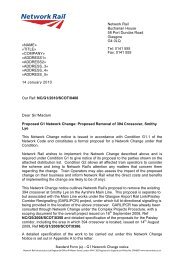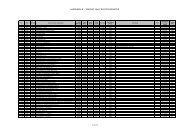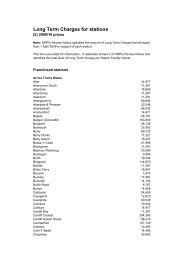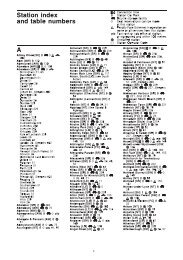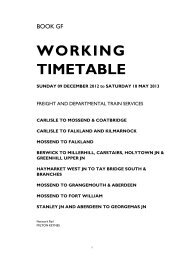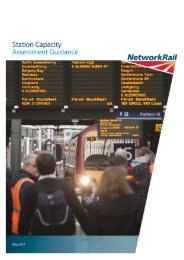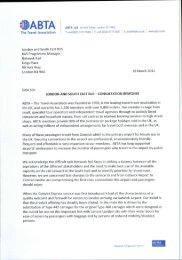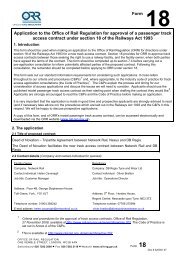Regulatory Financial Statements for the year ended ... - Network Rail
Regulatory Financial Statements for the year ended ... - Network Rail
Regulatory Financial Statements for the year ended ... - Network Rail
Create successful ePaper yourself
Turn your PDF publications into a flip-book with our unique Google optimized e-Paper software.
RAILTRACK PLC<br />
DIRECTORS’ REVIEW<br />
Material variations from <strong>the</strong> regulatory determination<br />
Income<br />
The main variance from <strong>the</strong> regulatory determination in terms of income is created by <strong>the</strong><br />
impact of schedule 8 and schedule 4 per<strong>for</strong>mance costs which have reduced franchise access<br />
income by £411 million. This is a reflection of <strong>the</strong> work undertaken to regain control of <strong>the</strong><br />
network post-Hatfield, outlined fur<strong>the</strong>r below. The overall income variance compared with <strong>the</strong><br />
determination is a positive variance of £73 million, as a consequence of <strong>the</strong> subsequent logging<br />
up of schedule 8 and schedule 4 costs as an adjustment to RAB in accordance with <strong>the</strong> <strong>Rail</strong><br />
Regulator’s statement of 27 June 2002, excess property profits and various incentive revenues.<br />
Expenditure<br />
The overall expenditure variance, be<strong>for</strong>e taking account of <strong>the</strong> <strong>Rail</strong> Regulator’s statement, was a<br />
negative variance of £566 million. The most significant factors that have caused this<br />
expenditure variance are:<br />
• Track renewals and maintenance have been subject to a complete review since<br />
Hatfield as <strong>Rail</strong>track regained engineering control of <strong>the</strong> network. Key drivers <strong>for</strong> <strong>the</strong><br />
increase in track renewals expenditure include an improved understanding of <strong>the</strong> condition<br />
of track assets and new in<strong>for</strong>mation on <strong>the</strong> rate of degradation of track assets (including <strong>the</strong><br />
emergence of Gauge Corner Cracking). The underlying drivers <strong>for</strong> <strong>the</strong> increase in<br />
maintenance include compliance with new (or clarified) standards, particularly in <strong>the</strong><br />
aftermath of Hatfield, new maintenance activities as a result of fur<strong>the</strong>r research undertaken<br />
following Hatfield (including rail grinding, train-borne ultrasonic inspections and <strong>the</strong><br />
installation of new lubricators), <strong>the</strong> roll out of <strong>the</strong> Maintenance In<strong>for</strong>mation Management<br />
System work management system and <strong>the</strong> impact of changing activity levels on unit costs.<br />
• Train control renewals, which comprises signalling and telecoms renewals, where <strong>the</strong><br />
company has significantly underspent <strong>the</strong> regulatory determination. This reflects slower<br />
than originally planned development of <strong>the</strong> Fixed Telecom <strong>Network</strong> and GSM-R and<br />
deferral of signalling expenditure, particularly on <strong>the</strong> West Coast Route Modernisation<br />
(“WCRM”) programme as <strong>the</strong> scope <strong>for</strong> Phase II has developed.<br />
• O<strong>the</strong>r costs, which comprise staff costs and o<strong>the</strong>r production and management costs have<br />
risen as a result of various items, particularly increased headcount (an 8% rise on <strong>the</strong><br />
previous <strong>year</strong>), <strong>the</strong> increased pension charges <strong>for</strong> <strong>the</strong> <strong>Rail</strong>track section of <strong>the</strong> <strong>Rail</strong>ways<br />
Pension Scheme as a consequence of a general fall in investment values, as well as <strong>the</strong><br />
impact of provisions against claims, <strong>the</strong> increased costs of insurance and some feasibility<br />
costs written off.<br />
RAB and RAB adjustments <strong>for</strong> 2006<br />
As outlined below, adjustments <strong>for</strong> amounts spent in excess of <strong>the</strong> regulatory determination<br />
have been incorporated into <strong>the</strong> RAB as an accumulated adjustment carried <strong>for</strong>ward to 2006,<br />
though any adjustment may be reflected earlier in <strong>the</strong> event of an interim review or an early<br />
periodic review. These adjustments total some £1,015 million. The reasons <strong>for</strong> <strong>the</strong> overspend<br />
are outlined above. In addition, o<strong>the</strong>r adjustments in respect of freight income shortfall<br />
following <strong>the</strong> withdrawal of <strong>the</strong> associated grant, volume, congestion, and broken rail incentives,<br />
deferred income and property renewals total £308 million. These latter income adjustments are<br />
2



